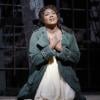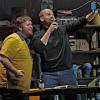
Composer Mason Bates has accomplished something remarkable in his first opera, The (R)evolution of Steve Jobs, which opened Friday at San Francisco Opera and runs through Oct. 7. While many new American operas look to ancient settings (John Adams’s Antony and Cleopatra) or previously untold stories (Terence Blanchard’s Fire Shut Up in My Bones), Bates and his librettist, Mark Campbell, chose a topic that’s of profound relevance to literally every audience member: the life and legacy of Steve Jobs.
The stakes were high. Bates needed to prove that opera — an art form that, let’s admit, is a bit of a historical relic — was a suitable medium for such a contemporary story. He also needed to address the elephant in the room: how to make sense of the contradictory relationship between Apple’s user-friendly, simplified design ethos and Jobs’s cruel and vindictive personality, which manifested both personally and professionally.
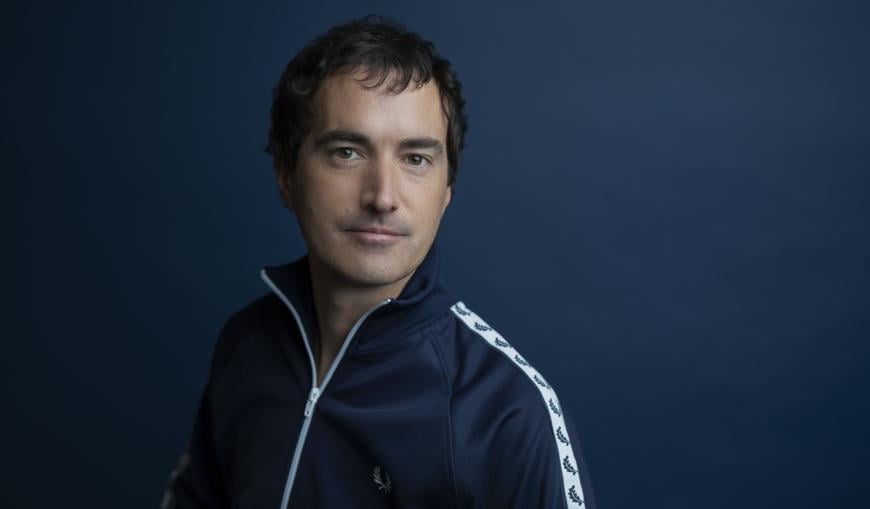
In its reimagination of the operatic form, the new work is a success. Bates smartly places the story of Apple — with its incalculable impact on our relationships with computers, phones, and even music (let’s not forget the transformational effect of the iPod) — in his signature pop-infused, ear-candy musical style. It’s the kind of stuff that modernists and avant-garde types scoff at, but like Apple’s products themselves, it’s music that is inviting to experts and newbies alike, and this is not to be scoffed at. With a run time of just over 90 minutes and its unabashed use of amplified voices and clear English diction, the opera has a format that makes perfect sense in a world accustomed to cinematic rather than operatic dramaturgy.
Our short attention spans are indulged by the frenetic one-act structure: 18 scenes, plus a prologue and epilogue, taken from Jobs’s life and pretty much all set in the Bay Area. The nonchronological narrative is presented as a trip down memory lane for Jobs (baritone John Moore), who, at the end of his life, reflects on its trajectory under the guidance of his spiritual mentor, Kōbun Chino Otogawa (bass Wei Wu). Moore is a spitting image of Jobs in his late-career signature black turtleneck and light-wash jeans, and he remains in this getup even as he revisits scenes from his youth.
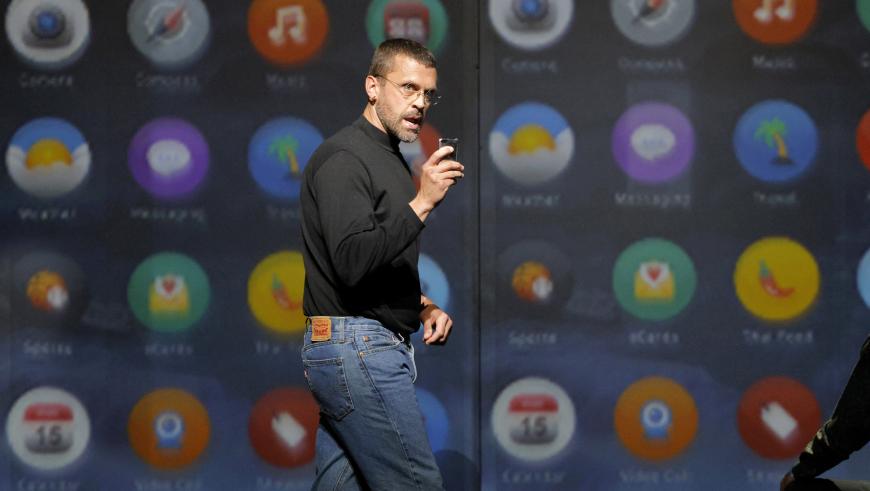
This detail should tip us off to the fact that we’re not getting unburnished history but rather a rose-tinted reminiscence of a turbulent life, bookended by two scenes showing Jobs as a 10-year-old boy (a non-singing role played Friday by Atom Young Maguire) at the workbench in his Los Altos family home, scenes with more than a bit of Norman Rockwell Americana kitsch.
It’s somewhat strange that Jobs maintains his late-career appearance throughout. We don’t get to see him as the disheveled and unwashed 20-something he was when he co-founded Apple. The scene in which the youthful Jobs and his partner Steve Wozniak (tenor Bille Bruley) giddily celebrate the invention of a new telephone contraption and rail against the “money-sucking, monolithic, monopolistic, autocratic” Bell Telephone Company serves as a setup for Wozniak to later accuse Jobs of having become “one of the people we hated.” But we never really get a sense of how downright strange the meditating, raw-vegan Jobs was in the 1970s. The scenes are arranged with a narrative arc in view, but this deprives a lot of the individual moments of their impact.
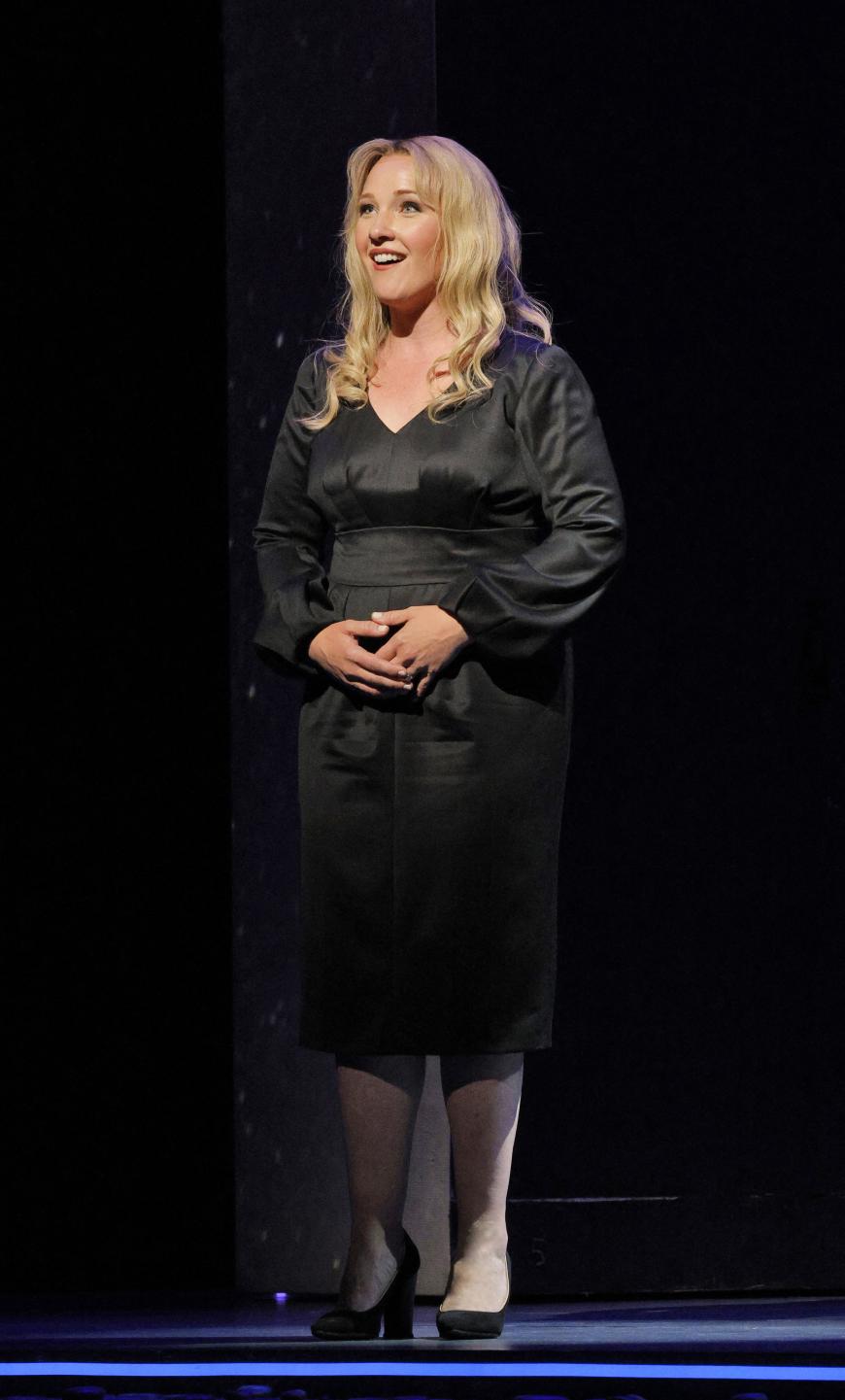
This arc is the opera’s biggest flaw, and it prevents Bates and Campbell from succeeding at their second task: reckoning with Jobs’s personal contradictions. The (R)evolution of Steve Jobs casts its protagonist’s biography as a redemption story. Under the guidance of his spiritual mentor and his caring wife, Laurene (mezzo-soprano Sasha Cooke in a splendidly warm performance), the troubled executive finds enlightenment, seeing the errors of his brutal treatment of others and warning against the dangers of getting lost in our devices. He comes full circle and “learns to be human again” — as Bates writes in his program note — a cyclic theme that is reinforced by the bookend garage scenes.
Whether or not this trajectory is true to life (it probably isn’t) is beside the point. The final few scenes — Jobs’s wedding to Laurene, in which he proclaims himself a changed man, and his memorial service at Stanford, the design of which he appears to humorously critique — are egregiously trite. The opera’s universalizing emphasis on the ultimate importance of “human connection” is so obvious and unobjectionable as to be meaningless.
And the piece’s engagement with Zen Buddhism — a system of thought that Jobs spent years studying and practicing — is superficial and borderline offensive. Bates and Campbell should have known better than to use the hackneyed trope of the Eastern spiritual mentor, worst of all accompanying him with stereotypically exotic low flutes and gongs.
The overemphasized redemptive tone of the piece allows Bates and Campbell to avoid dealing meaningfully with the troubling aspects of Jobs’s life and legacy. Bates’s program note blithely mentions Jobs’s “occasional dismissiveness of those who fell out of favor” but ultimately lionizes the man as a “creative” (as a noun, a grating neologism of marketing speak), the type of person who is often “animated by intriguing conflicts and tempestuous lovers.”
This is a cheerful gloss on a man who long refused to acknowledge his first daughter (dragging her mother’s name through the mud in a legal effort to deny paternity), stiffed early members of Apple out of stock options when the company went public, and subjected employees to verbal abuse and summary termination. (This is not to mention ills like concealing human rights abuses in Chinese factories behind a benevolent and ethics-conscious brand image, the sort of broader social problem the opera does not address.) By inventing a story in which Jobs is reconciled with the errors of his ways, Bates and Campbell avoid a certain complexity, delivering a neatly packaged moralistic conclusion instead of embracing the more challenging ambiguity of their subject.
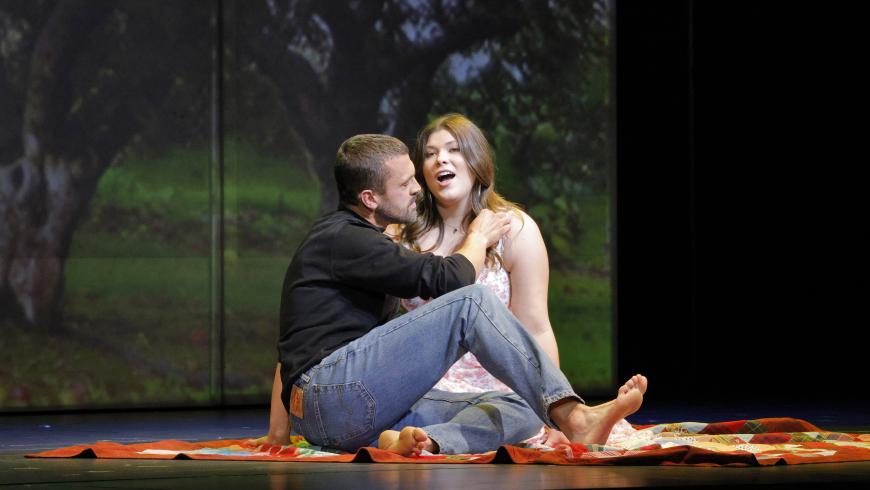
The personal incidents mentioned above, like the cruel treatment of Jobs’s ex-girlfriend, Chrisann Brennan (soprano Olivia Smith), are indeed depicted in the opera, but Bates’s bubbly, chirpy musical style, well suited to the feverish spirit of innovation that animated Apple, never finds a compelling analog for these darker moments. Smith portrayed Brennan with a grounded presence and poignant charisma, but it’s a casualty of the opera’s uncritical hero worship that its only female characters are reduced to the roles of nagging girlfriends and wives.
On a technical level, the opera left little to be desired. The orchestra, effectively commanded by Michael Christie, rippled with sparkling and gratifying details (including Bates’s own contributions from two laptops in the pit). The production, based on Apple’s own minimalistic design elements, created a believable sense of place.
But taken as a whole, the piece is too drawn in by Jobs’s own analogy between technology and art. Apple revolutionized the aesthetics of personal computers, but the company designs products, not artworks. Placing the “creative technologist” in the lineage of the artist, as Bates does in his program note, abets the sinister encroachment of corporations into culture itself.
Artists are not entrepreneurs or company executives. Their primary job isn’t to make profits but to make us think. With its would-be affirming message, The (R)evolution of Steve Jobs is a marketer’s dream, if we assume that people want their music to be like their computers: intuitive, easy to use, and ultimately replaceable in two years. But audiences deserve to be challenged as well as affirmed. Moving kaleidoscopically from moment to moment and scene to scene, the easy redemption of Jobs presented by this opera withholds the possibility of engaging with the urgent problems the work claims to confront.



